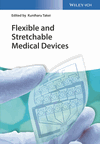History of Flexible and Stretchable Devices
Kuniharu Takei
Osaka Prefecture University, Department of Physics and Electronics, 1-1 Gakuen Nakaku, Sakai, Osaka, 599-8531 Japan
Search for more papers by this authorKuniharu Takei
Osaka Prefecture University, Department of Physics and Electronics, 1-1 Gakuen Nakaku, Sakai, Osaka, 599-8531 Japan
Search for more papers by this authorKuniharu Takei
Osaka Prefecture University, Department of Physics and Electronics, 1-1 Gakuen Nakaku, Sakai, 599-8531 Osaka, Japan
Search for more papers by this authorSummary
This introduction presents an overview of the key concepts discussed in this book. The book introduces the fundamental physics of electrical components such as flexible and stretchable transistors, memories, and sensors to understand the present status of the flexible and stretchable electronics including techniques to fabricate the devices as emerging technologies. Flexible devices such as transistors and transducers have been developed since 1990 by forming the organic thin film or transferring inorganic thin film on plastic substrates. The book describes the medical and healthcare applications using the flexible and stretchable device components. It discusses the skin-mounted healthcare devices, implantable medical devices, and neuroscience devices. In addition to the device applications, the book also discusses the nanosheet materials for the practical medical and wearable sheets. Recently, fully printed, multifunctional, low-cost, wearable flexible healthcare devices have been reported by integrating with multiple sensors for healthcare detections and human activity.
References
- Garnier, F., Horowitz, G., Peng, X., and Fichou, D. (1990) Adv. Mater., 2, 592.
- Gustafsson, G., Cao, Y., Treacy, G.M., Klavetter, F., Colaneri, N., and Heeger, A.J. (1992) Nature, 357, 477.
- Garnier, F., Hajlaoui, R., Yassar, A., and Srivastava, P. (1994) Science, 265, 1684.
- Rogers, J.A., Bao, Z., Baldwin, K., Dodabalapur, A., Crone, B., Raju, V.R., Kuck, V., Katz, H., Amundson, K., Ewing, J., and Drzaic, P. (2001) Proc. Natl. Acad. Sci. U.S.A., 98, 4835.
- Konagai, M., Sugimoto, M., and Takahashi, K. (1978) J. Cryst. Growth, 45, 277.
- Yablonovitch, E., Gmitter, T., Harbison, J.P., and Bhat, R. (1987) Appl. Phys. Lett., 51, 2222.
- Hur, S.-H., Khang, D.-Y., Kocabas, C., and Rogers, J.A. (2004) Appl. Phys. Lett., 85, 5730.
- Menard, E., Lee, K.J., Khang, D.Y., Nuzzo, R.G., and Rogers, J.A. (2004) Appl. Phys. Lett., 84, 5398.
- Sun, Y. and Rogers, J.A. (2004) Nano Lett., 4, 1953.
- Ahn, J.H., Kim, H.S., Lee, K.J., Jeon, S., Kang, S.J., Sun, Y., Nuzzo, R.G., and Rogers, J.A. (2006) Science, 314, 1754.
- Khang, D.-Y., Jiang, H., Huang, Y., and Rogers, J.A. (2006) Science, 311, 208.
- Sun, Y., Choi, W.M., Jiang, H., Huang, Y.Y., and Rogers, J.A. (2006) Nat. Nanotechnol., 1, 201.
- Cao, Q., Kim, H.S., Pimparkar, N., Kulkarni, J.P., Wang, C., Shim, M., Roy, K., Alam, M.A., and Rogers, J.A. (2008) Nature, 454, 495.
- Ko, H.C., Stoykovich, M.P., Song, J., Malyarchuk, V., Choi, W.M., Yu, C.J., Geddes, J.B. III Xiao, J., Wang, S., Huang, Y., and Rogers, J.A. (2008) Nature, 454, 748.
- Yoon, J., Baca, A.J., Park, S.I., Elvikis, P., Geddes, J.B. III Li, L., Kim, R.H., Xiao, J., Wang, S., Kim, T.H., Motala, M.J., Ahn, B.Y., Duoss, E.B., Lewis, J.A., Nuzzo, R.G., Ferreira, P.M., Huang, Y., Rockett, A., and Rogers, J.A. (2008) Nat. Mater., 7, 907.
- Rogers, J.A., Lagally, M.G., and Nuzzo, R.G. (2011) Nature, 477, 45.
- Wang, C., Takei, K., Takahashi, T., and Javey, A. (2013) Chem. Soc. Rev., 42, 2592.
- Kim, D.H., Viventi, J., Amsden, J.J., Xiao, J., Vigeland, L., Kim, Y.S., Blanco, J.A., Panilaitis, B., Frechette, E.S., Contreras, D., Kaplan, D.L., Omenetto, F.G., Huang, Y., Hwang, K.C., Zakin, M.R., Litt, B., and Rogers, J.A. (2010) Nat. Mater., 9, 511.
- Mannsfeld, S.C., Tee, B.C., Stoltenberg, R.M., Chen, C.V., Barman, S., Muir, B.V., Sokolov, A.N., Reese, C., and Bao, Z. (2010) Nat. Mater., 9, 859.
- Takei, K., Takahashi, T., Ho, J.C., Ko, H., Gillies, A.G., Leu, P.W., Fearing, R.S., and Javey, A. (2010) Nat. Mater., 9, 821.
- Kim, D.H., Lu, N., Ma, R., Kim, Y.S., Kim, R.H., Wang, S., Wu, J., Won, S.M., Tao, H., Islam, A., Yu, K.J., Kim, T.I., Chowdhury, R., Ying, M., Xu, L., Li, M., Chung, H.J., Keum, H., McCormick, M., Liu, P., Zhang, Y.W., Omenetto, F.G., Huang, Y., Coleman, T., and Rogers, J.A. (2011) Science, 333, 838.
- Kim, H.S., Brueckner, E., Song, J., Li, Y., Kim, S., Lu, C., Sulkin, J., Choquette, K., Huang, Y., Nuzzo, R.G., and Rogers, J.A. (2011) Proc. Natl. Acad. Sci. U.S.A., 108, 10072.
- Tee, B.C., Wang, C., Allen, R., and Bao, Z. (2012) Nat. Nanotechnol., 7, 825.
- Hammock, M.L., Chortos, A., Tee, B.C., Tok, J.B., and Bao, Z. (2013) Adv. Mater., 25, 5997.
- Wang, C., Hwang, D., Yu, Z., Takei, K., Park, J., Chen, T., Ma, B., and Javey, A. (2013) Nat. Mater., 12, 899.
- Jeong, J.W., Kim, M.K., Cheng, H., Yeo, W.H., Huang, X., Liu, Y., Zhang, Y., Huang, Y., and Rogers, J.A. (2014) Adv. Healthc. Mater., 3, 642.
- Harada, S., Honda, W., Arie, T., Akita, S., and Takei, K. (2014) ACS Nano, 8, 3921.
- Harada, S., Kanao, K., Yamamoto, Y., Arie, T., Akita, S., and Takei, K. (2014) ACS Nano, 8, 12851.
- Honda, W., Harada, S., Ishida, S., Arie, T., Akita, S., and Takei, K. (2015) Adv. Mater., 27, 4674.
- Kaltenbrunner, M., Adam, G., Glowacki, E.D., Drack, M., Schwodiauer, R., Leonat, L., Apaydin, D.H., Groiss, H., Scharber, M.C., White, M.S., Sariciftci, N.S., and Bauer, S. (2015) Nat. Mater., 14, 1032.
- Honda, W., Arie, T., Akita, S., and Takei, K. (2015) Sci. Rep., 5, 15099.
- Zang, Y., Zhang, F., Huang, D., Gao, X., Di, C.A., and Zhu, D. (2015) Nat. Commun., 6, 6269.
- Honda, W., Arie, T., Akita, S., and Takei, K. (2016) Adv. Mater. Technol., 1, 1600058.
- Gao, W., Emaminejad, S., Nyein, H.Y., Challa, S., Chen, K., Peck, A., Fahad, H.M., Ota, H., Shiraki, H., Kiriya, D., Lien, D.H., Brooks, G.A., Davis, R.W., and Javey, A. (2016) Nature, 529, 509.
- Someya, T., Sekitani, T., Iba, S., Kato, Y., Kawaguchi, H., and Sakurai, T. (2004) Proc. Natl. Acad. Sci. U.S.A., 101, 9966.
- Someya, T., Kato, Y., Sekitani, T., Iba, S., Noguchi, Y., Murase, Y., Kawaguchi, H., and Sakurai, T. (2005) Proc. Natl. Acad. Sci. U.S.A., 102, 12321.
- Sekitani, T., Nakajima, H., Maeda, H., Fukushima, T., Aida, T., Hata, K., and Someya, T. (2009) Nat. Mater., 8, 494.
- Kim, D.H., Lu, N., Ghaffari, R., Kim, Y.S., Lee, S.P., Xu, L., Wu, J., Kim, R.H., Song, J., Liu, Z., Viventi, J., de Graff, B., Elolampi, B., Mansour, M., Slepian, M.J., Hwang, S., Moss, J.D., Won, S.M., Huang, Y., Litt, B., and Rogers, J.A. (2011) Nat. Mater., 10, 316.
- Hwang, S.-W., Tao, H., Kim, D.-H., Cheng, H., Song, J.-K., Rill, E., Brenckle, M.A., Panilaitis, B., Won, S.M., Kim, Y.-S., Song, Y.M., Yu, K.J., Ameen, A., Li, R., Su, Y., Yang, M., Kaplan, D.L., Zakin, M.R., Slepian, M.J., Huang, Y., Omenetto, F.G., and Rogers, J.A. (2012) Science, 28, 1640.
- Tao, H., Hwang, S.W., Marelli, B., An, B., Moreau, J.E., Yang, M., Brenckle, M.A., Kim, S., Kaplan, D.L., Rogers, J.A., and Omenetto, F.G. (2014) Proc. Natl. Acad. Sci. U.S.A., 111, 17385.
- Kaltenbrunner, M., Sekitani, T., Reeder, J., Yokota, T., Kuribara, K., Tokuhara, T., Drack, M., Schwodiauer, R., Graz, I., Bauer-Gogonea, S., Bauer, S., and Someya, T. (2013) Nature, 499, 458.
- Yamamoto, Y., Harada, S., Yamamoto, D., Honda, W., Arie, T., Akita, S., and Takei, K. (2016) Sci. Adv., 2, e1601473.
- Kim, J., Salvatore, G.A., Araki, H., Chiarelli, A.M., Xie, Z., Banks, A., Sheng, X., Liu, Y., Lee, J.W., Jang, K.-I., Heo, S.Y., Cho, K., Luo, H., Zimmerman, B., Kim, J., Yan, L., Feng, X., Xu, S., Fabiani, M., Gratton, G., Huang, Y., Paik, U., and Rogers, J.A. (2016) Sci. Adv., 2, e1600418.
- Fukuda, K., Minamiki, T., Minami, T., Watanabe, M., Fukuda, T., Kumaki, D., and Tokito, S. (2015) Adv. Electron. Mater., 1, 1400052.
- Lee, H., Choi, T.K., Lee, Y.B., Cho, H.R., Ghaffari, R., Wang, L., Choi, H.J., Chung, T.D., Lu, N., Hyeon, T., Choi, S.H., and Kim, D.-H. (2016) Nat. Nanotechnol., 11, 566.
- Larson, C., Peele, B., Li, S., Robinson, S., Totaro, M., Beccai, L., Mazzolai, B., and Shepherd, R. (2016) Science, 351, 1071.
- Yokota, T., Zalar, P., Kaltenbrunner, M., Jinno, H., Matsuhisa, N., Kitanosako, H., Tachibana, Y., Yukita, W., Koizumi, M., and Someya, T. (2016) Sci. Adv., 2, e1501856.



